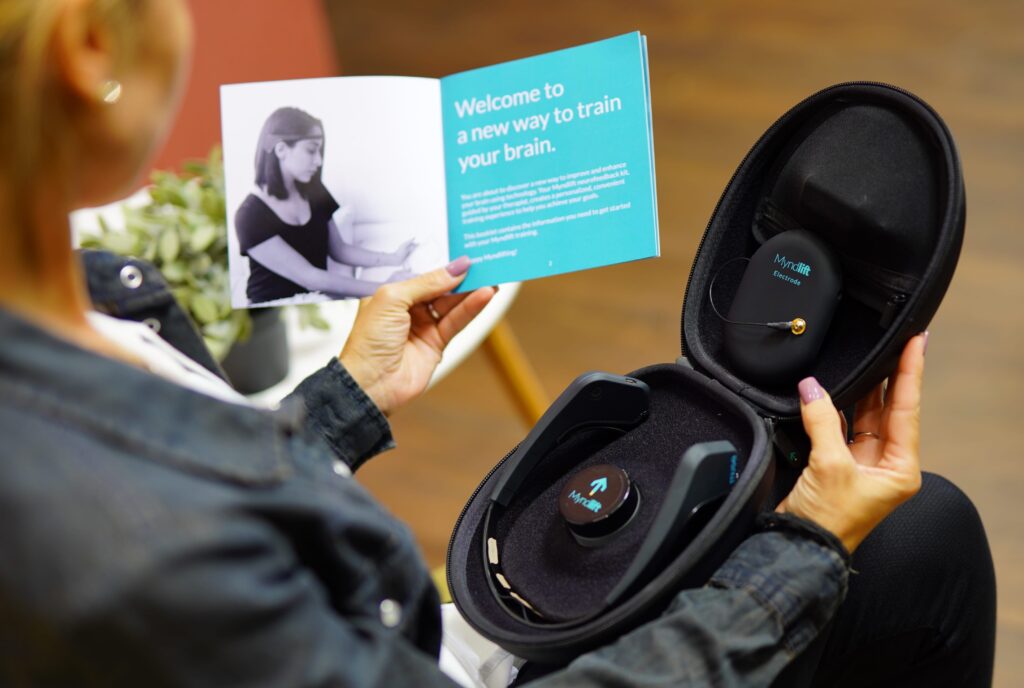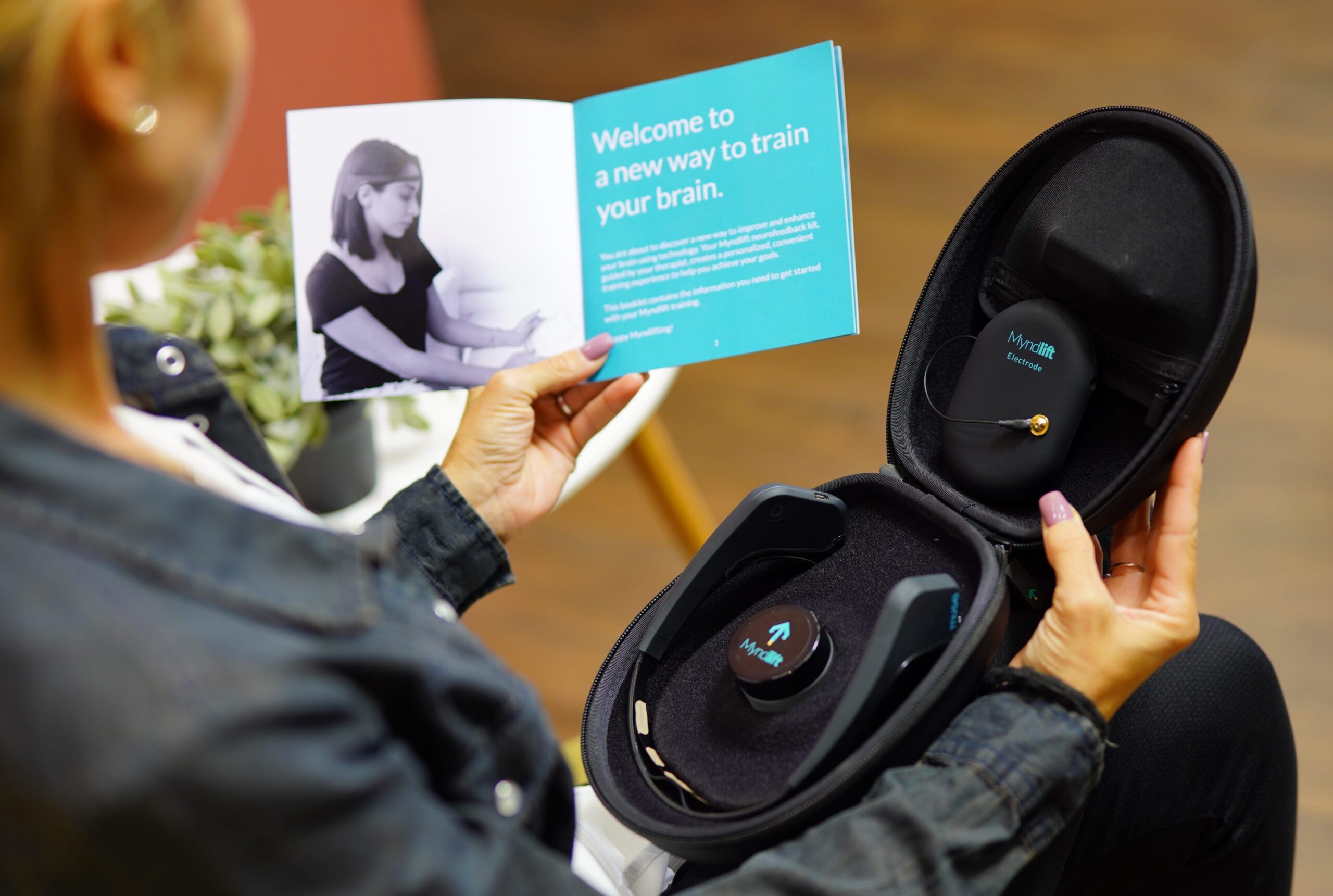In the journey of sobriety, particularly for women, finding effective tools to support long-term recovery can be challenging. While spiritual connection and community support form the foundation of many recovery journeys (as beautifully illustrated in our recent Confident Sober Women podcast episode with Louise), there’s another powerful tool emerging that’s helping sober women transform their recovery experience: neurofeedback therapy at home.
As someone who works with women in recovery, I’ve seen firsthand how the brain plays a crucial role in maintaining sobriety. Today, I want to dive deep into how at-home neurofeedback is becoming a game-changer for many in the recovery community, offering a scientific complement to spiritual and community-based approaches.
What Exactly Is Neurofeedback at Home, and Why Does It Matter for Recovery?
Neurofeedback is a type of biofeedback that focuses specifically on brain activity. Using electroencephalography (EEG) technology, neurofeedback allows individuals to observe their brain’s electrical activity in real-time and then learn to regulate it. Think of it as a personal trainer for your brain—teaching it new, healthier patterns of functioning. You can learn more with my FREE download “Is Neurofeedback Therapy Right For You?”
For women in recovery, this matters enormously. Here’s why:
When we consume alcohol or other substances over extended periods, our brain adapts to their presence. It adjusts its chemistry and functioning to accommodate these substances, which is partly why stopping can be so difficult. Once sober, the brain needs to relearn how to function optimally without them.
Many women in recovery struggle with:
- Persistent anxiety that threatens to trigger relapse
- Sleep disturbances that leave them exhausted
- Difficulty concentrating and staying focused
- Emotional regulation challenges
- Brain fog or cognitive slowing
These aren’t character flaws or signs of weakness—they’re neurological realities that can persist long after the last drink. This is where neurofeedback at home comes into play.
The Science Behind Neurofeedback for Recovery
At its core, neurofeedback works through a process called operant conditioning. When your brain produces desired patterns of activity, you receive positive feedback (usually in the form of a game advancing, music playing, or visual rewards). When your brain produces undesired patterns, the feedback stops.
Over time, through this reward system, your brain learns to produce healthier patterns more consistently—even when you’re not actively doing neurofeedback.
Research has shown promising results for neurofeedback in addressing many issues common in recovery:
- Reducing anxiety and depression: A meta-analysis published in the Journal of Clinical Psychiatry found neurofeedback to be effective in reducing symptoms of anxiety and depression—both common challenges in early sobriety.
- Improving sleep quality: Multiple studies have demonstrated neurofeedback’s effectiveness in improving sleep onset, duration, and quality—critical factors in recovery as the brain heals.
- Enhancing focus and attention: Research suggests neurofeedback can help improve executive functioning, something many women report struggling with in early recovery.
- Reducing cravings: Some studies indicate that neurofeedback may help reduce cravings and improve impulse control, vital components of relapse prevention.
What makes this particularly exciting is that we’re now able to bring this technology directly into people’s homes through remote neurofeedback therapy programs.
The Revolution of Neurofeedback at Home
Traditionally, neurofeedback required visiting a clinician’s office several times a week for sessions—a significant barrier for busy women balancing recovery with work, family, and other responsibilities. The financial investment could also be prohibitive for many.
Remote neurofeedback therapy changes this equation entirely. Here’s how at-home neurofeedback typically works:
- Initial assessment: First, you’ll complete a comprehensive brain assessment to identify your specific neurological patterns and challenges.
- Equipment setup: You’ll receive user-friendly EEG equipment that connects to your computer or tablet at home.
- Regular sessions: You’ll conduct neurofeedback sessions at home on your own schedule—typically 2-3 times per week for optimal results.
- Professional guidance: Despite being remote, you still receive professional guidance through regular check-ins with a neurofeedback specialist who monitors your progress and adjusts protocols as needed.
- Progress tracking: Advanced software tracks your brain’s changing patterns over time, allowing you to see your progress objectively.
The benefits of this at-home approach are substantial:
- Convenience: No more driving to appointments or arranging childcare
- Consistency: More regular sessions lead to better outcomes
- Comfort: Sessions in your own safe environment
- Cost-effectiveness: Often more affordable than in-office treatment
- Integration: Easier to incorporate into your existing recovery routine

Research-Backed Evidence for Neurofeedback in Recovery
The effectiveness of neurofeedback for recovery support is backed by a growing body of research:
A 2023 study published in the Journal of Substance Abuse Treatment followed 45 individuals in early recovery who used at-home neurofeedback systems. After 12 weeks, participants showed a 62% reduction in reported cravings and significant improvements in sleep quality compared to the control group.
Research from UCLA’s Department of Psychiatry found that individuals who incorporated regular neurofeedback training at home were 28% less likely to relapse during the first year of recovery compared to those receiving standard care alone.
A 2022 systematic review in Frontiers in Neuroscience analyzed 18 studies on neurofeedback for substance use disorders, concluding that “home-based neurofeedback protocols show particular promise for maintaining long-term benefits, likely due to the increased frequency and consistency of training sessions.”
What Recovery Specialists Are Saying About Neurofeedback at Home
Addiction specialists and recovery coaches have been increasingly incorporating neurofeedback at home into their treatment recommendations:
Dr. Sarah Johnson, addiction psychiatrist and researcher, notes: “The accessibility of at-home neurofeedback has been revolutionary for my patients. Many who struggled with persistent neurological symptoms despite maintaining sobriety are now experiencing significant improvements in sleep, anxiety, and cognitive clarity.”
Recovery coach Michael Torres shares: “I’ve observed remarkable differences in clients who add neurofeedback at home to their recovery toolkit. Their emotional regulation improves, and they report feeling ‘more present’ during spiritual practices and group support meetings.”
Neuroscientist Dr. Rebecca Chen explains: “What makes neurofeedback at home particularly effective for recovery is that it directly addresses the neurological dysregulation caused by substance use. As the brain learns healthier patterns through consistent training, we see improvements across multiple domains of functioning.”
Practical Tools You Can Use Right Now
While formal neurofeedback therapy requires specific equipment, there are several brain-regulation techniques you can begin practicing immediately to start experiencing some benefits:
1. Box Breathing for Nervous System Regulation
This simple technique helps activate the parasympathetic nervous system (rest-and-digest mode):
- Inhale for a count of 4
- Hold for a count of 4
- Exhale for a count of 4
- Hold for a count of 4
- Repeat for 5 minutes
This structured breathing pattern helps regulate brain activity and reduce anxiety. Practice it whenever you feel overwhelmed or before potentially triggering situations.
2. Progressive Brain-Body Scan
This exercise helps increase awareness of brain-body connections:
- Sit or lie comfortably with eyes closed
- Starting at the top of your head, bring awareness to each part of your body
- Notice any tension, sensations, or emotions stored there
- As you move down your body, visualize releasing any tension
- Pay particular attention to how your thoughts affect physical sensations
Regular practice strengthens the connection between mind and body, improving self-regulation—a key skill in recovery.
3. Bilateral Stimulation
This technique, borrowed from EMDR therapy, helps balance brain hemispheres:
- Sit comfortably and place your hands on your thighs
- Alternately tap your right and left thighs at a comfortable pace
- Continue for 1-2 minutes while focusing on calm breathing
- Practice when feeling anxious or when cravings arise
Many people report this simple exercise helps reduce the intensity of challenging emotions.
4. Brain-Nutrition Connection
What you eat significantly impacts brain function during recovery:
- Incorporate omega-3 rich foods (salmon, walnuts, flaxseeds)
- Ensure adequate B-vitamin intake (whole grains, leafy greens)
- Stay hydrated—aim for half your body weight in ounces daily
- Minimize sugar and processed foods, which can trigger brain inflammation
These nutrition basics support optimal brain function as you heal.
5. Sleep Hygiene for Brain Recovery
Quality sleep is essential for brain healing:
- Maintain consistent sleep/wake times
- Create a dark, cool sleeping environment
- Avoid screens 1-2 hours before bed
- Develop a calming bedtime ritual
- Consider magnesium glycinate before bed (consult your healthcare provider)
Prioritizing sleep gives your brain the restoration time it needs to form new, healthy pathways.
Is Neurofeedback at Home Right for You?
While these self-help techniques are valuable, they’re often just the beginning of what’s possible with structured neurofeedback training. You might consider exploring remote neurofeedback therapy if:
- You’ve established some sobriety but still struggle with anxiety, sleep issues, or focus problems
- You’ve done the “inner work” but feel your brain hasn’t caught up with your spiritual progress
- You’ve tried meditation but find it difficult to quiet your mind
- You experience emotional reactivity that threatens your recovery
- You’re looking for evidence-based tools to complement your spiritual practice
Many women find that adding neurofeedback to their recovery toolkit provides the missing piece—especially those who feel they’ve plateaued in their growth or continue to struggle with specific symptoms despite doing everything “right.”
The Integration of Spiritual and Neurological Approaches
In our podcast conversation with Louise, she beautifully described her spiritual awakening as a cornerstone of her recovery: “Every single decision I’ve made since I got sober has involved sitting with my god.” This profound spiritual connection provided the foundation she needed to transform her life.
What’s fascinating is how neurofeedback can complement this spiritual approach. By optimizing brain function, neurofeedback often makes spiritual practices more accessible and effective. Many practitioners report that clients experience deeper meditation, greater emotional presence, and enhanced intuition after regular neurofeedback training.
As Louise said in our conversation, “I didn’t get sober just to be in this. If I’m going to be sober, there’s going to be so much more that I can do.” Neurofeedback helps make that “more” possible by addressing the neurological aspects of recovery.
Taking the Next Step
If you’re curious about how neurofeedback at home might support your recovery journey, I invite you to download my free guide: “Is Neurofeedback Right for You?” This comprehensive resource walks you through:
- A self-assessment to determine if neurofeedback might help your specific challenges
- The science behind neurofeedback in simple, accessible language
- What to expect from remote neurofeedback therapy
- How to integrate neurofeedback with your existing recovery practices
- Common questions and concerns about the process
To access this free guide, simply visit www.shelbyjohn.com and enter your email. You’ll receive the guide immediately, along with additional resources to support your recovery journey.
Ready to explore neurofeedback more deeply? I offer complimentary consultation calls to discuss your unique situation and determine if remote neurofeedback therapy might be beneficial for you. During this call, we’ll:
- Review your recovery journey so far
- Identify specific challenges you’re facing
- Discuss how neurofeedback might address these challenges
- Answer any questions you have about the process
- Determine next steps if you decide to move forward
You can schedule this consultation directly through my website at www.shelbyjohn.com.
Conclusion: A Holistic Path Forward
The journey of recovery is multifaceted, involving spiritual, psychological, social, and neurological dimensions. As we heard in our podcast conversation with Louise, spiritual connection provided her with the foundation she needed to transform her life beyond simply not drinking.
Similarly, neurofeedback at home offers another powerful dimension to recovery—addressing the neurological patterns that can either support or hinder our growth. By combining these approaches, we create a more comprehensive path toward lasting transformation.
As sober women, we deserve every tool available to support our healing. Remote neurofeedback therapy represents an exciting frontier in recovery support—making advanced brain training accessible to women regardless of location or schedule constraints.
Whether you’re newly sober or years into your journey, if you’re looking to optimize your brain function and enhance your recovery experience, I encourage you to explore how neurofeedback at home might support your path. Your brain’s remarkable ability to change and heal—its neuroplasticity—remains active throughout your life. Neurofeedback simply helps guide that change in the direction of greater well-being and resilience.
The journey continues, and with each new tool we discover, the path becomes richer and more sustaining. Here’s to your continued growth, healing, and transformation—one brain wave at a time.
If you found this article helpful, please share it with another sober woman who might benefit from learning about neurofeedback at home. Together, we strengthen our recovery community by sharing resources and hope.



